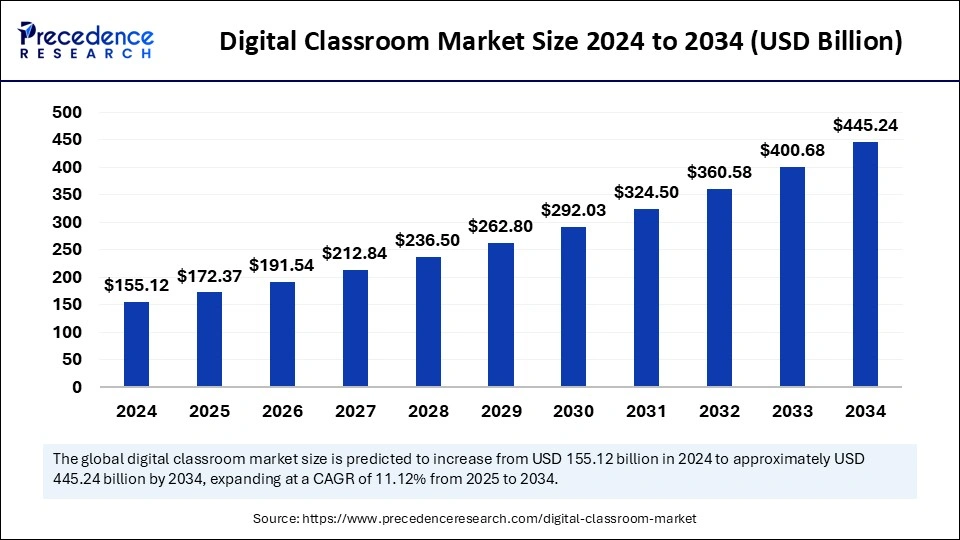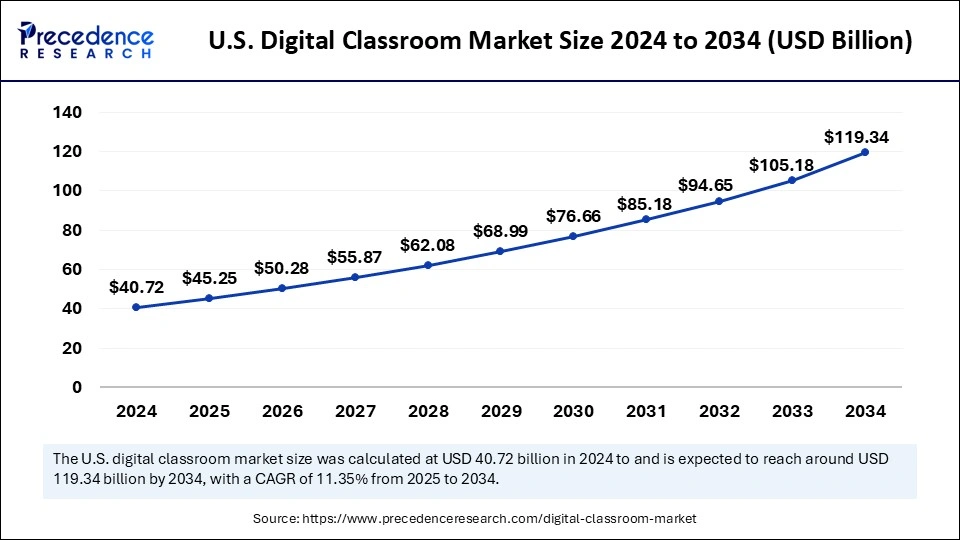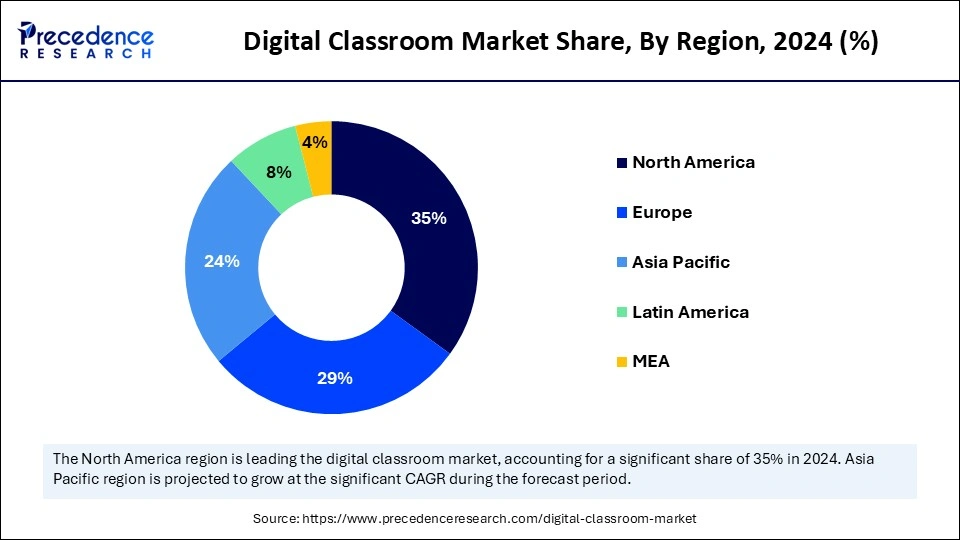January 2025
The global digital classroom market size is calculated at USD 172.37 billion in 2025 and is forecasted to reach around USD 445.24 billion by 2034, accelerating at a CAGR of 11.12% from 2025 to 2034. The North America market size surpassed USD 54.29 billion in 2024 and is expanding at a CAGR of 11.27% during the forecast period. The market sizing and forecasts are revenue-based (USD Million/Billion), with 2024 as the base year.
The global digital classroom market size accounted for USD 155.12 billion in 2024 and is predicted to increase from USD 172.37 billion in 2025 to approximately USD 445.24 billion by 2034, expanding at a CAGR of 11.12% from 2025 to 2034. The market is expanding due to enhanced accessibility, hybrid and online learning approaches, individualized education, AI incorporation, and unconventional techniques such as gamification and virtual reality, fueled by technological progress and student needs.

Artificial intelligence is transforming the digital classroom market by offering personalized learning opportunities and automating administrative duties. It assesses the performance and learning preferences of each student, enabling educational platforms to customize content and teaching approaches to address varying requirements. This customization boosts student involvement and enhances academic performance by helping suit individual difficulties. AI-powered tools simplify grading and assessment tasks, offering educators important insights while minimizing their workload. Real-time analytics assist in pinpointing areas that require additional assistance, while tools such as speech-to-text and language translation improve accessibility for students facing disabilities or language obstacles.
The U.S. digital classroom market size was exhibited at USD 40.72 billion in 2024 and is projected to be worth around USD 119.34 billion by 2034, growing at a CAGR of 11.35% from 2025 to 2034.

The Dominance of North America in the Digital Classroom Market
North America dominated the digital classroom market with the largest share in 2024. This is because of its strong technological framework and extensive incorporation of digital tools in education. The educational institutions in the area are pioneers in utilizing advanced technologies bolstered by considerable investment from both the public and private sectors. This dedication to innovation has resulted in the widespread adoption of hybrid learning models that blend conventional in-person teaching with online elements. Extensive internet access and the presence of advanced devices facilitate the smooth execution of digital classrooms by improving the entire educational experience. The implementation of hybrid learning models focusing on tailored education has further propelled market expansion.
Hybrid Learning Boosts U.S. Market Dominance
The U.S. led the digital classroom market in 2024, driven by substantial investments from both government and private sectors. Federal financial support for high-speed internet and devices has improved digital infrastructure in educational institutions. The focus on STEM education has heightened the utilization of interactive resources like virtual laboratories. Moreover, the growth of hybrid and remote education has increased the need for cloud-based solutions.

Asia Pacific: Driving Digital Education Transformation
Asia Pacific is anticipated to grow at the fastest rate in the market during the forecast period because of government programs that encourage digital transformation in education. Nations such as India, China, and Japan are focusing on advancing digital infrastructure to enhance access to education and cultivate a digitally empowered community. The rising popularity of mobile devices and cost-effective internet access has allowed e-learning platforms to reach both urban and rural regions. The growing middle-class demographic and focus on quality education boost the need for sophisticated learning tools, including gamification and virtual reality-enhanced content. Cooperative initiatives among governments and private entities are also broadening the scope and efficacy of digital classrooms in the area.
India: Powering Digital Classrooms with Innovation
India stands as a prominent participant in the digital classroom sector, propelled by governmental efforts, increased internet access, and a rising need for quality education. The Digital India program, which has set aside approximately USD 2 billion from 2021 to 2026, seeks to enhance digital infrastructure and foster digital literacy. The presence of budget-friendly smartphones and internet connectivity, especially in rural regions, has enhanced the accessibility of e-learning platforms. The increasing middle-class demographic and focus on STEM education have further boosted the growth of tailored and engaging learning solutions.
China: Key Driver in the Digital Classroom Market
The digital classroom market in China is growing because of governmental backing, investments in tech, and an emphasis on merging technology with education. The Smart Education initiative and the broad access to inexpensive devices and fast internet have enabled the uptake of e-learning. The competitive education culture in China and the need for online tutoring platforms have further increased market penetration. The embrace of innovative technologies by the government, such as blockchain, and the implementation of interactive tools in STEM education have enhanced market expansion. Collaborations between technology firms and academic organizations highlight the dedication of China to progress in digital classroom innovations.
Europe: A Notable Region in the Digital Classroom Market
Europe is expected to grow at a considerable growth rate in the upcoming period, characterized by a strong educational framework, high internet access, and governmental backing at the forefront of the digital classroom industry. Nations such as Germany, the UK, and France are implementing digital tools and platforms. The Digital Education Action Plan 2021-2027 of the European Union seeks to enhance high-quality, inclusive digital education and training. The emphasis of the region on hybrid learning approaches, STEM education, and AI integration reinforces its position as a leader in innovative classroom solutions.
A digital classroom is an educational environment that incorporates technology to improve the learning experience, making use of multimedia tools such as videos, interactive simulations, and e-books. This setting encourages teamwork between students and teachers, improving overall learning results. The market encompasses hardware, software, and services such as smartboards, virtual classrooms, learning management systems, and e-learning tools designed to enhance teaching effectiveness, boost student involvement, and optimize learning results.
The digital classroom market represents a significant change in educational settings, incorporating technology to improve teaching and learning experiences. Notably, the market has revolutionized conventional educational approaches into contemporary, engaging, and effective strategies, catering to various learning requirements and difficulties via the vibrant environment fostered by technology-based solutions.
| Report Coverage | Details |
| Market Size by 2034 | USD 445.24 Billion |
| Market Size in 2025 | USD 172.37 Billion |
| Market Size in 2024 | USD 155.12 Billion |
| Market Growth Rate from 2025 to 2034 | CAGR of 11.12% |
| Dominated Region | North America |
| Fastest Growing Market | Asia Pacific |
| Base Year | 2024 |
| Forecast Period | 2025 to 2034 |
| Segments Covered | Product Type, Application, and Regions |
| Regions Covered | North America, Europe, Asia-Pacific, Latin America and Middle East & Africa |
Increasing Demand for Interactive and Personalized Learning
The increasing demand for interactive and personalized learning experiences is driving the digital classroom market. This demand is mostly driven by technological improvements, particularly the incorporation of AI, augmented reality (AR), and virtual reality (VR) into educational settings. These technologies increase engagement and tailor learning to specific student needs, resulting in a more engaging and personalized learning experience.
Disparate technology access and the digital divide
The digital divide, a major restraint to the digital classroom market, has been exacerbated by discrepancies in internet connectivity, availability of affordable devices, and digital literacy levels. Rural and undeveloped areas frequently lack reliable high-speed internet, cutting students and instructors off. Infrastructure issues such as power outages and a lack of technology-based classrooms aggravate the digital divide, limiting access to digital learning opportunities.
Integration of AI and Personalized Learning Technologies
The outlook for education is encouraging because of the incorporation of AI and Machine Learning technologies. These technologies provide tailored experiences, streamlining administrative duties and delivering predictive analytics. This collaboration improves educational results by customizing learning to meet the specific needs of each student, thus boosting engagement and effectiveness in the digital classroom market.
The digital classroom hardware segment held a dominant presence in the digital classroom market in 2024, mainly because of its contribution to establishing efficient digital learning spaces. Essential tools such as interactive whiteboards, projectors, tablets, and laptops boost classroom participation and simplify teaching approaches. Educational institutions are allocating resources to these instruments to enhance interactive and multimedia-enriched content, promoting a more captivating learning environment. The emphasis on developing intelligent classrooms and providing students with contemporary learning resources boosts the need for digital classroom equipment in schools.
The digital classroom software segment is projected to grow with the fastest CAGR in the market, influenced by the need for engaging and customized learning experiences. Advanced technologies such as Learning Management Systems (LMS), online learning platforms, and AI-enhanced educational software are fueling this expansion. The transition to blended and online learning formats hastened by the COVID-19 pandemic has increased the demand for strong software solutions. Support services, such as educator training, IT assistance, and consulting, are crucial for the integration and enhancement of digital learning tools in educational establishments.
The higher education segment dominated the digital classroom market in 2024. This is due to the increasing use of modern digital technologies, such as virtual lecture platforms, collaboration software, and mobile learning systems, to address the growing need for flexible and accessible education. The shift to hybrid learning models, which blend in-person and online instruction, boosts student engagement and prepares them for a technology-driven workforce, aligning educational outcomes with industrial objectives. This educational transition guarantees that students have the digital skills they need to work in a technology-driven workforce.
The K-12 segment is projected to expand rapidly in the market in the coming years. This is because of its demand for personalized learning experiences, government funding for educational technology, and a shift toward hybrid and remote learning models. Interactive whiteboards, learning management systems, and gamified content are critical for increasing student engagement and meeting a variety of learning demands. The COVID-19 pandemic has hastened the adoption of these technologies, with virtual reality headgear and AI-powered personalized learning solutions revolutionizing classrooms.

By Product Type
By Application
By Geography
For inquiries regarding discounts, bulk purchases, or customization requests, please contact us at sales@precedenceresearch.com
No cookie-cutter, only authentic analysis – take the 1st step to become a Precedence Research client
January 2025
January 2025
August 2024
October 2024